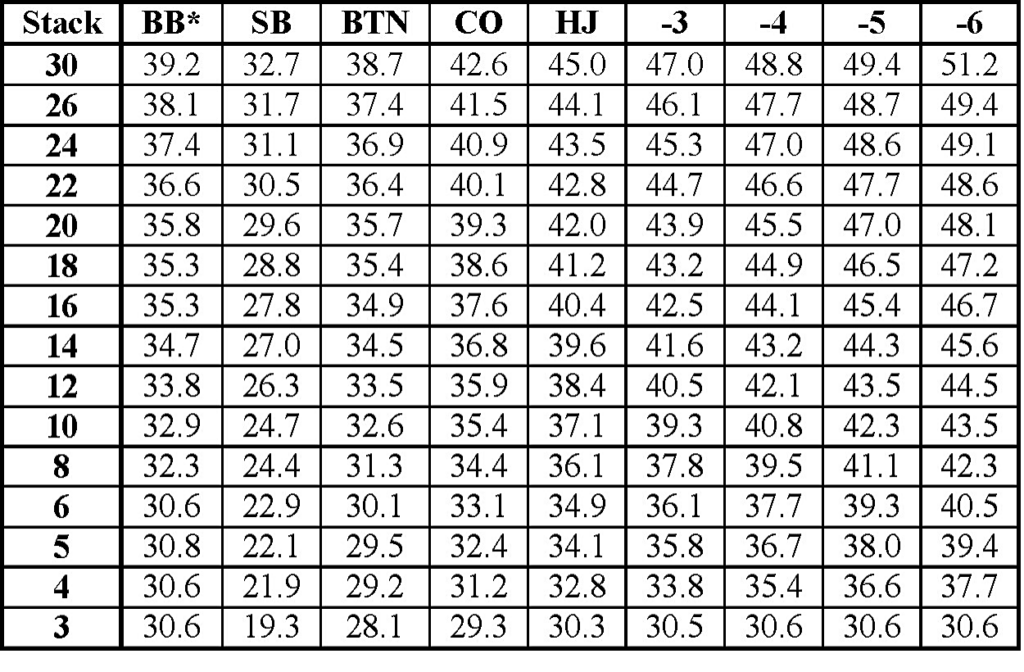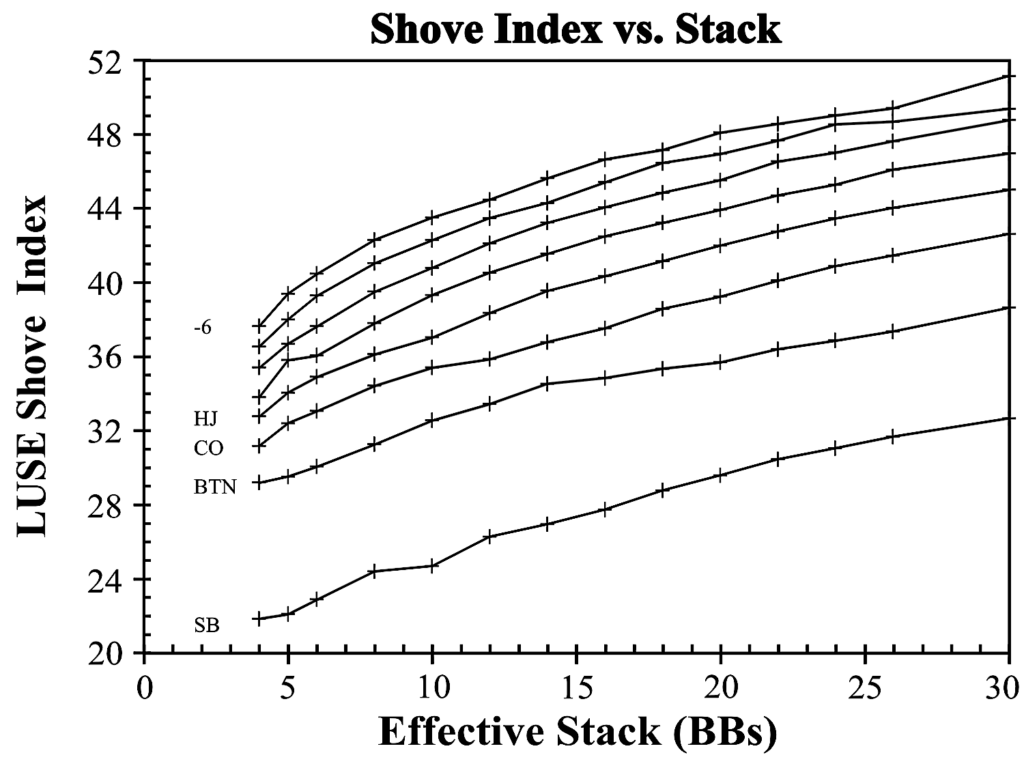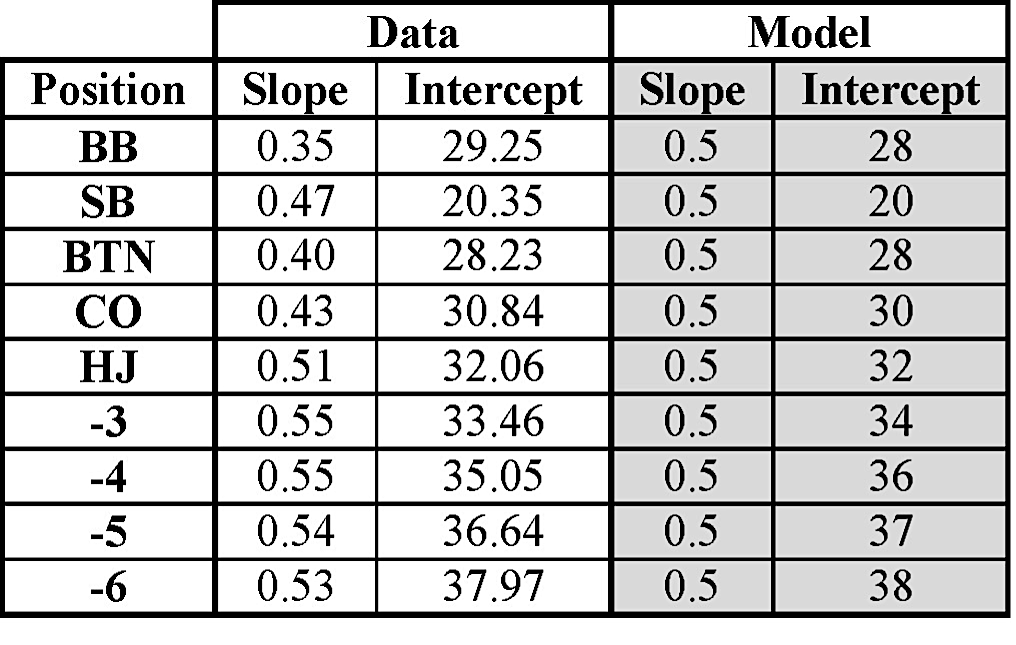“It used to be considered an art form to win a tournament without having to shove all your chips in the middle.” — Phil Helmuth
This is the third in a series of articles introducing my GTO holy grail algorithms These articles are based on my newest book, Lectures on Poker, Volume 1: Small Stack Tournament Strategy.
GTO open shoving
Any player who employs a GTO tournament strategy must study and practice a great deal in order to approximate perfect performance. This study requirement is much less severe when we use the open-shoving index system I introduced in Part 2, shown again in Figure 1.

We simply look at this chart (perhaps on our smartphone) before the cards are dealt. Once we see our hand, we calculate its combo power index (CPI). If the CPI is higher than the chart value, we have an unexploitable GTO shove. Of course, this doesn’t mean we should shove, only that will be +EV to do so since our opponents will be making GTO calling errors.
I used an early version of this chart in live poker tournaments for more than a year with good results. Occasionally, someone would ask what I was looking at, and I told them “It’s just my poker system.” I could even show them the chart and they would have no idea what I was actually doing.
I was watching a rerun of the 2019 WSOP Main Event and I thought: “What would I do in that situation? Can I really look at my chart on national TV?” Although this wouldn’t break any rules, I would prefer that my opponents didn’t know I was using a GTO strategy. So I began to think about how I could simplify the system so it could be easily committed to memory. That became my GTO holy grail quest.
Patterns upon patterns
My system is based on game theory situations and the patterns that appear in their solutions. Look again at Figure 1. Do you see any patterns? Neither did I. But the patterns are there.
If we plot the open-shoving index vs. effective stack size (Figure 2), we discover something very interesting: the lines are quasi-parallel to each other. This means we can characterize each column of Figure 1 as a straight line with a slope and an intercept, even though the lines are not perfectly straight.

Let’s look at these curves where they appear to be generally linear, between 6 and 20 BB effective stacks. This is also the region of greatest importance for jamming. The slopes and intercepts for these curves are summarized in the “Data” columns of Figure 3.

The slopes of these curves range between 0.35 and 0.55, which are actually quite similar. If we could remember these slopes and intercepts, and if we could do the calculations in our head, we could use these values to get a precise GTO shoving range in a live tournament without looking at any notes.
The holy grail open-shoving algorithm
Although some of us might be able do this, most of us need a simpler, more practical method. One simplification is to use the same slope for every stack size. Another is to use integer values for the intercepts.
The average of these slopes is 0.48, so a slope of 0.50 is a natural choice for our model with the benefit of being easy to use at the table. Then we simply determine which integer value fits the data best, summarized in the last column of Figure 3. Now we have the holy grail algorithm for GTO open-shoving: open-shove index = stack/2 + (position index)
Using this algorithm is simple. We just:
- Divide the effective stack, in BBs, by two (or multiply by 0.5)
- Add an integer that depends on our position (the position index, from Figure 4)

This is very easy to implement at a live table. You could inscribe these numbers on your card protector or simply remember them. The position index is the keystone of the holy grail system.
One final point: there is no true position index for an open shove from the big blind. If the small blind open-completes, we can use PI=28. But that is problematic since we don’t really know the small blind’s completion range. And since we can just check our option, we should generally just make a sound poker decision.
The 18-point big blind index in Figure 4 is used for calling a shove and reshoving from the big blind. (This is discussed at length in the book.)
Holy grail errors
You might wonder about the size of the errors generated by the holy grail algorithm. I cover this very carefully in the book; suffice it to say, the average error with 6-20 BB effective stacks is only 0.4 index points. This error increases to about one point with 24 BB stacks and to about two points with 30 BB stacks. These errors are conservative, meaning we would be shoving with a slightly too-tight range.
And since our opponents nearly always call a shove too tightly, our holy grail shoving algorithm always represents the tight limit to our GTO range.
We can quibble about whether this is truly a GTO system when we utilize approximations and accept small errors. Perhaps we could call it quasi-GTO, but even with its small errors, the holy grail algorithms will produce much better results than we could ever achieve by trying to memorize a myriad of complex charts.
Example
We’re in the cutoff with 12 BBs and the players on our left have 15-18 BB stacks each. We are not close to the bubble. It folds to us and we find QTo, which has a CPI of 37 points (2×12+10+3). Our open-shoving index from the cutoff is 36 points (30+12/2), so we have a borderline GTO shove here. Since the stacks on our left would be crippled if they call and lose, they will nearly always call too-tightly.
Therefore, an open-shove will be +EV. So we can shove and win either 2.5 or 14.5 BBs, or go home knowing we made a strong, mathematically correct play.
Summary
Now we have a system that we can use at the table with no need for a cheat sheet. We simply memorize the CPI and position index algorithms, which is easy to do. Nevertheless, having a GTO open-shoving hand doesn’t mean we must shove. We may wish to just open, or sometimes even fold.
The next installment in our series will extend our Holy Grail system to shoving over limpers.


